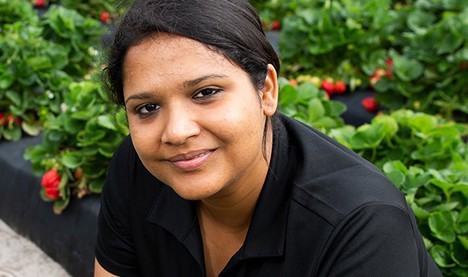With about 11,000 acres — mostly in west-central Florida — strawberries are worth $399 million annually in Florida. That represents 10% of the national strawberry value and most of the domestically produced winter crop in the United States.
Those economic figures make it critical for strawberry growers to keep pests and diseases at bay. While producers began planting for this year’s harvest in October, they’re acutely aware of the potential scourge of the two-spotted spider mite, which eats into their fruit.
Farmers find it difficult to manage bugs and pathogens with conventional sprays. But University of Florida scientists have found that by shining UV light on a research field of strawberries in the middle of the night, they can zap spider mites. Soon, scientists hope commercial farmers will be able to use this method.

Researchers such as Natalia Peres, a plant pathologist at the UF/IFAS Gulf Coast Research and Education Center (GCREC), have already shown they can use the ultraviolet lamp to thwart strawberry pathogens in the field.
Now, in a new study led by Sriyanka Lahiri, UF/IFAS researchers have found the UV lamp can effectively control the mites by applying light twice a week, at night.
The study gives scientists and growers data about the amount of UV light necessary to significantly reduce the number of spider mite eggs in strawberry fields – without reducing fruit yield, she said.
“An added advantage is that UV light does not leave any residue behind and can be applied using automated robotic units already in production by commercial sources,” said Lahiri, a UF/IFAS assistant professor of entomology, also at GCREC.
Combining measures
Because spider mites and thrips are more difficult to control using these doses of UV light at night, scientists need to explore a combination of insecticides and higher doses of UV light.
“Since very few miticides (sprays) are currently effective in suppressing two-spotted spider mites in strawberries, the use of UV light provides an effective physical control method that can be used in fields and in high-tunnel strawberry production systems,” Lahiri said. “If left unmanaged, this pest will feed voraciously on leaves and cover the plant with webbing, causing tremendous fruit loss.”
Peres sees even more possibilities for UV lamp technology.
“UV is another tool in the growers’ constant fight against pests and diseases,” she said. “It is particularly effective against diseases and pests that are present on the surface of the plants. Thus, other tools are still needed for those pathogens that are more deeply colonized into the strawberry tissue or flying insects that might not be present at the time of the application.”
For more information: UF/IFAS
UF/IFAS
www.ifas.ufl.edu
